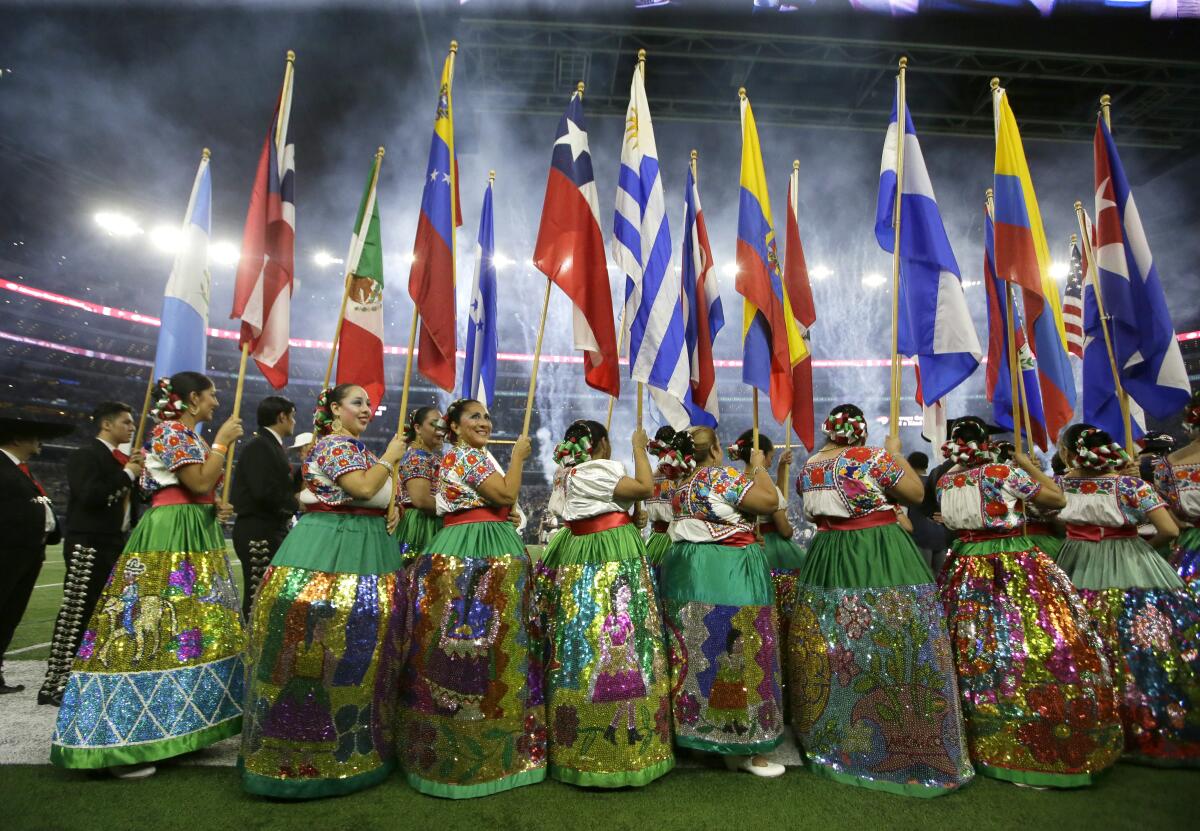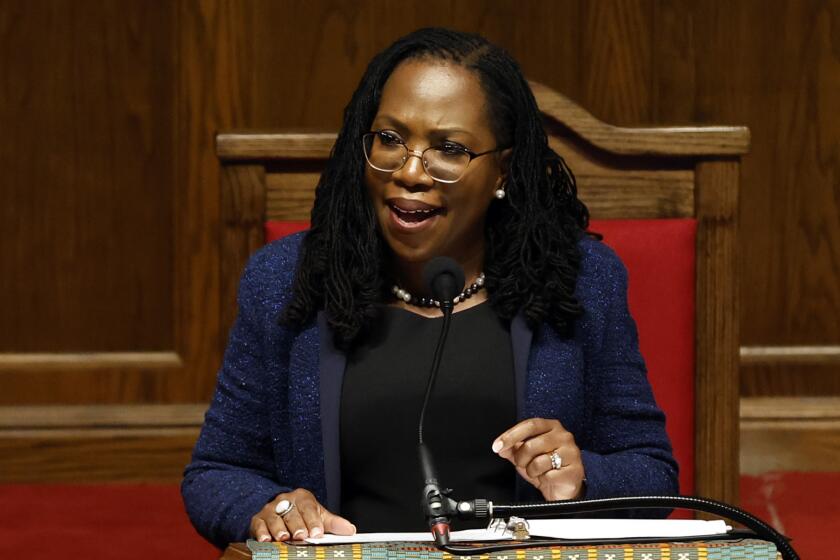National Hispanic Heritage Month highlights cultural diversity of Spanish-speaking Americans

- Share via
PHOENIX — Latino history and culture take center stage across the U.S. for National Hispanic Heritage Month, which is celebrated annually from Sept. 15 to Oct. 15. The celebration recognizes the contributions of the fastest-growing racial or ethnic minority in the U.S., according to the census.
It includes people whose ancestors come from Spain, Mexico, the Caribbean and Central and South America.
With a U.S. population of more than 63 million people, there will be a plethora of Hispanic Heritage Month celebrations all over the country.
At an Alabama church where four Black girls were killed by a Ku Klux Klan bomb 60 years ago, the Supreme Court justice says the nation must own its past.
How did it come to be?
Before there was National Hispanic Heritage Month, there was Hispanic Heritage Week, created through legislation sponsored by Mexican American Rep. Edward R. Roybal of Los Angeles and signed into law in 1968 by President Lyndon B. Johnson. The annual celebration was to be held the week that included Sept. 15-16.
The weeklong commemoration was expanded to a month two decades later, with legislation signed into law by President Reagan.
Sept. 15 was chosen as the starting point, to coincide with the anniversary of the “Cry of Dolores,” or “Grito de Dolores,” issued in 1810 from a town in central Mexico that launched that country’s war for independence from Spain.
The Central American nations of Guatemala, Honduras, El Salvador, Nicaragua and Costa Rica celebrate their independence on Sept. 15, and Mexico marks its national day on Sept. 16, the day after the cry for independence.
Also during National Hispanic Heritage Month, the South American nation of Chile observes its independence day on Sept. 18. Indigenous Peoples’ Day, previously known as Columbus Day, is observed in the U.S. on the second Monday of October.
The four-week period is about honoring how Latino populations have shaped the U.S. in the past and present.
What is the socioeconomic outlook for Latinos?
Latinos account for the fastest-growing portion of the national gross domestic product, said Luisa Godinez-Puig, an equity scholar with nonprofit research organization Urban Institute. The GDP of Latinos was an estimated $2.8 trillion in 2020, compared with $2.1 trillion in 2015 and $1.7 trillion in 2010.
It’s a contradiction to the fact that Latinos still face obstacles with personal finances. Surveys show median wealth is five times lower for Latino families than their white counterparts. Less than half own their own homes, Godinez-Puig added.
“Their needs are not being met,” Godinez-Puig said. “Not having access to banking products, not having access to investment, not having access to credit — all of these things impact the wealth, building opportunities of families, which are passed from generation to generation.”
What is the origin of the term ‘Hispanic’?
“Hispanic” was a term created by the federal government for people descended from Spanish-speaking cultures, said Anita Huízar-Hernández, associate director of Arizona State University’s Hispanic Research Center. But for some, the label has a connotation of political conservatism and emphasizes a connection to Spain.
“I think the most important thing to acknowledge is that people have their own definition of those terms,” Huízar-Hernández said. “They don’t always match. And that is very dependent on your generation, it’s dependent on the part of the country that you live in.”
For some, Latino reflects their ties to Latin America. So you may see some celebrations referred to as Latinx or Latin Heritage Month.
What are some of the celebrations that are happening?
From Los Angeles to Tampa, Fla., there is no shortage of festivities. Most are touting traditional Latin foods and entertainment like mariachi bands, folklórico dancing and salsa lessons. The revelry doesn’t just showcase Mexican culture but Puerto Rican, Colombian and a host of others.
There are also events spotlighting Latino Americans in various industries like Suave Fest, a Latino Craft Beer Festival in Denver on Sept. 30, and the New York Latino Film Festival, which runs Friday through Sept. 24.
The Smithsonian Institution in Washington, D.C., is offering a slate of activities elevating Hispanic heritage. Its National Portrait Gallery will be teaming up with Lil’ Libros, a bilingual children’s book publisher for the second Fotos & Recuerdos Festival. There will be story times, arts and craft workshops and gallery tours.
The U.S. Postal Service has put its own stamp on the occasion. Earlier this month, the agency released new Forever stamps featuring piñatas. The handmade party favorites are typically associated with parties where blindfolded guests try to crack one open to get to the candy inside. But their history can be traced to the 16th century.
Corporations also partake in the celebrations. Walt Disney World Resort has chosen this week to debut live-action versions at Magic Kingdom Park of Mirabel and Bruno, two popular characters from the animated hit “Encanto.” The movie, about a family in Colombia with extraordinary abilities, is credited with showing a large audience the nuances of Colombian culture.
“It’s not Mexico and you can see them eating different foods and you can see like the music is different,” said Huízar-Hernández, who is Mexican American. “Movies, TV, that’s the way a lot of people learn.”
A future source of learning will be the highly anticipated Smithsonian National Museum of the American Latino on the National Mall. In 2020, Congress passed bipartisan legislation to establish the museum.
The legislation also called for an American Latino History and Culture grant program. This summer Urban Institute researchers, like Godinez-Puig, have been working with the Institute of Museum and Library Services on how to dole out federal grants for American Latino museums and their programming. This initiative reflects the growing number of places occupied by Latino culture, she said.
“As a Latina woman, myself, I’m just very excited to see that we ... not just only talk about where we are lagging, but also celebrate the variety of cultures that we have within our community and celebrate the hard-working people that contribute a lot to the American society,” Godinez-Puig said. “Because they do.”
More to Read
Sign up for Essential California
The most important California stories and recommendations in your inbox every morning.
You may occasionally receive promotional content from the Los Angeles Times.











